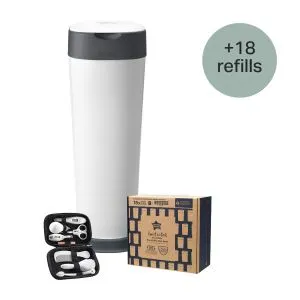
Ultimate XL Nappy Disposal Bundle with 18 Refills
Bundle & Save 40%
Subscription orders can be cancelled at anytime. Free delivery on all subsequent subscription orders. Find out more about subscriptions.
They’re easy and fuss free
Your products are automatically sent to you
You save up to 10% when you sign up for a subscription
You can cancel at any time

As a soon-to-be parent, the thought of labour can be daunting and overwhelming. One of the most common questions expecting parents have is, "What do contractions feel like?".
Contractions are a sign that your body is preparing for childbirth, but everyone experiences them differently. Some describe them as menstrual cramps, while others compare them to intense pressure or tightening.
In this blog, we'll explore early labour pains, Braxton Hicks, and the different types of contractions and what they feel like so that you can be better prepared for the big day.
Contractions feel very different for every pregnant person and it's hard to describe exactly how they will feel for you.
Usually, people experience a wave of pain that peaks and then eases. Some people find them very painful, while others find them easier to manage.
They're sometimes described as a tightening and hardening of the stomach followed by pain with extreme cramping in your lower stomach, and some people feel contractions in their back, and this is usually because of the position of their baby.
Typically, contractions are a sign that labour is starting, so if you're experiencing them, you should speak to your midwife or maternity unit.
Early contractions can feel like a dull ache or cramp in the lower abdomen or back, like menstrual cramps. Some people may also experience a tightening or pressure sensation in the pelvic area. Early contractions are not as intense as full labour contractions.
Every person's experience of contractions is unique, and where you feel contraction pain depends on the position of your baby.
If your baby is head down but looking forward, you may feel them most in your back. If they're positioned differently, you may feel them in your lower stomach where period cramps typically occur. Some people also feel pain at the top of their legs.
Contractions typically start in the back or lower abdomen.
Contractions are typically a sign that labour is about to begin. They happen when your uterus tightens during a contraction and your cervix opens to push the baby down and out.
Let's run through the different kinds of contractions one by one.
These tightenings (that begin at the top of your bump and spread down) are usually not too painful and can be experienced during pregnancy, particularly in the second or third trimester. They usually last for between 30 and 60 seconds and are expected. Think of them as your body getting ready for the real thing during birth.
If you experience actual labour contractions before your pregnancy reaches full term, these are referred to as preterm contractions. This term is used when labour commences before you hit the 37th week of pregnancy. Don't hesitate to get in touch with your midwife or doctor if you think you may be going into premature labour.
These are the real deal, aka the contractions that don't subside and result in the birth of your baby. Typically, they happen a week or two before or after your due date, but if you think you might be experiencing them at any point during your pregnancy, it's crucial to contact your doctor or midwife right away.
Not sure whether what you're feeling are Braxton Hicks or true labour contractions? It's best to ask your midwife or doctor for advice.
During the early (latent) stage of labour, many people experience other symptoms alongside contractions. Let's run through the other signs of labour to look out for.
As you approach labour, you may experience a discharge of mucus from your cervix, known as a show. This jelly-like pink mucus may come out in one piece or several and contains a small amount of blood. It's a sign that your cervix is starting to open, but labour may occur immediately or take a few days. Keep in mind that not all pregnant people experience a show.
Baby's head is pressing on your bowel and bladder can cause a sudden urge to pee or poo.
Some people feel sick suddenly and develop an unusual backache when their labour is starting.
During labour, the sac surrounding the baby ruptures, and clear and pale amniotic fluid drains out through the vagina. This is commonly referred to as "waters breaking" and can happen at the start of labour, later during labour, or even before labour starts in some cases.
This is a sure sign that baby will arrive soon and it's common to go into labour within 24 hours of your waters breaking, but it's often not as dramatic as the movies make it out to be! Some people only experience a slow trickle of amniotic fluid, while others experience a sudden gush.
Once you suspect your waters have broken, you should contact your maternity unit or midwife.
Your midwife or doctor may offer to break your waters when you're in labour if they've not already broken naturally, and you should tell your midwife immediately if:
If you have any concerns about your contractions or labour, it's always best to speak with your healthcare provider.
Early labour can take a long time, but you should call the midwife if:
Let's run through some of the ways you can help manage the pain of contractions throughout labour. Remember that everyone is different, what helps one person, may not work so well for another, so it's important to advocate for yourself and be clear about what you need during labour.